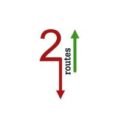A popular trading indicator is the Relative Strength Index (RSI). It is an oscillator that measures the recent price movements of an asset to determine if it’s overbought or oversold.
Here’s a simplified example of how RSI works:
The RSI is typically displayed as a line on a scale of 0 to 100.
Generally, an RSI above 70 suggests the asset might be overbought (price may be due for a decline).
An RSI below 30 indicates the asset might be oversold (price may be due for a rise).
Example:
Imagine you’re looking at the RSI for a stock. The RSI has been steadily climbing for the past few days and is now at 85. This could be a sign that the stock is overbought and its price may be due to fall. You might decide to wait for the RSI to come down before buying the stock.
Important to Consider:
RSI is just one indicator and shouldn’t be used alone for making trading decisions.
You should always consider other factors, such as the overall market trend and news events, before buying or selling an asset.
There are different interpretations of RSI levels. Some traders might consider an RSI above 80 as overbought, while others might use a higher threshold.
It’s important to do your own research and understand the limitations of any trading indicator before using it in your investment strategy.

